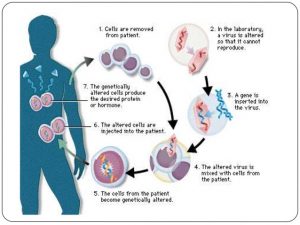What is the first thing you think of when you hear gene therapy? Some of the words that come to mind may be unnatural, suspicious, or even has potential. Gene therapy is a type of treatment used to treat or prevent diseases. While it is still under research to determine its effectiveness and potential hazards, this technology could be the answer to curing certain diseases.
What are Genes?
Genes, located inside chromosomes, are made up of DNA and have a role in making proteins. In other words, genes act as a blueprint for the body. Every person obtains a copy of each gene from their parents. Everyone’s genes are slightly different which explains why we look like our parents but are still unique. Genes can range in size depending on the species being looked at. For example, Escherichia coli has around 5,500 genes, a mouse has around 23,000, and humans contain around 25,000 genes. Eukaryotes, organisms with a nucleus inside their cells, contain coding and non-coding regions inside their genome. The coding-regions code for functional proteins while the non-coding regions do not. Most plant and animals genomes have a large portion of non-coding regions that are suspected to help regulate how genes are expressed[3].

How does gene therapy work?
Gene therapy can be used to restore a mutation or replace a defective gene with a healthier one. In order to place a gene inside of a cell, a vector is needed. The vector, usually a virus, is used to deliver the gene to a designated spot. The vector is genetically engineered so that it will not cause disease when it is inside a human cell. As soon as the DNA sequence is dropped off, it will start producing proteins that restore the cell to its normal function. It is rare but a vector can sometimes insert the DNA into the wrong place. If inserted into a gene that regulates when a gene is turned on or off, it can possibly lead to cancer[1].
Some methods of insertion include injection, intravenously into a specific tissue, or it can be done in a laboratory. A patient’s cells are removed and then introduced to the vector so that the engineered virus will never be in the human body. The cells that now carry the vector and the healthy gene are returned to the patient[4]. Gene therapy is still being tested in clinical trials but there has been success in humans. The first successful gene therapy trial treated a four year old child who was prone to repeated infections. In 1990, researchers at the National Institutes of Health helped treat this rare genetic disease called adenosine deaminase deficiency[1].

This graph shows the steps in gene therapy
What diseases can be treated using gene therapy?
Some of the diseases that have been used in gene therapy human clinical trials include severe combined immunodeficiency diseases, cystic fibrosis, and Cabavan’s disease. Other diseases like cancer, AIDS, Alzheimer’s diseases, and cardiovascular diseases are possible candidates for gene therapy. There are about 4,000 diseases have have been traced to gene disorders. [1]
What else can gene therapy do?
According to the American Medical Association, gene therapy can also:
- Deliver genes to destroy cancer cells or make cancer cells return back to normal
- Deliver viral or bacterial genes that act as vaccinations
- Deliver genes that help new tissue grow or help regenerate damaged tissue
Gene therapy progress
Gene therapy depends on the ability for the vector to deliver the gene. Other methods are being researched to make gene therapy more efficient and safe for use. A few of the methods mentioned by T Niidome and L Huang include: gene delivery using a chemical carrier, lipid-mediated gene delivery, peptide-mediated gene delivery, and polymer gene delivery. The safest gene therapy method is to use naked DNA without having to use a vector. This method is also hard to do because of rapid degradation after injection but certain techniques can be used to enhance gene uptake. Vein injection, local injection, ultrasound, artery injection, electroporation, or a gene gun can be used for enhancement. [2]
Final Thoughts
Gene therapy is still in the early stages of research but has huge potential to treat certain diseases. New techniques are currently being developed and tested to ensure safety and efficiency. Even though we are far from perfecting gene carriers, this technique could potentially help thousands of children born with immunodeficiency problems.
Nick Leschly went on TED Talks to talk about gene therapy. For those interested in learning more about gene therapy or just wants to hear what he has to say, look up Gene therapy–The time is now; Nick Leschly at TEDxBoston or click here.

Nick Leschly as he talks about gene therapy on TED Talks
References
Gene Therapy [Internet], AMA Publications; [cited 2016 September 18]. Available from http://www.amaassn.org/ama/pub/physician-resources/medical-science/genetics-molecular medicine/current- topics/gene-therapy.page?
Niidome, T. Huang, L. Gene Therapy Progress and Prospects: Nonviral vectors, Gene Therapy (2002) 9, 1647–1652
Herron JC, Freeman S. Evolutionary Analysis. 5th ed. Glenview, IL: Pearson Eduction, Inc; 2015. (582-584).
How does gene therapy work? [Internet], [updated 2016 September 13], U.S Department of Health and Human Services; [cited 2016 September 18]. Available from https://ghr.nlm.nih.gov/primer/therapy/procedures
Thanks for writing this. I’ve heard of gene therapy before, but I never knew what it was. I found it interesting when you were talking about the different ways the DNA can be introduced to the cell.
This seemed much more professional than the post I put on my page and it reads very well. I liked how you just put the facts out there and tried not to be biased when informing people about this topic. Gooood Work!
Awesome post Kate, I’m a huge gene therapy fan.
What are your thoughts on the CRISPR/Cas9 system for target genome editing? In my opinion, CRISPRs can circumvent a lot of the problems that researchers run into with retroviral or adenoviral vectors. Additionally, CRISPRs allow for pinpoint precision for editing. Here’s a Nature news piece if you’re interested http://www.nature.com/news/crispr-gene-editing-is-just-the-beginning-1.19510
I found this to be really interesting! I never knew that gene therapy required a vector like a virus. Is this the kind of stuff that you’re wanting to end up doing? Because if so, then that’s really cool. It’ll be neat to see what advancements we can make in the next few decades.
Hey!
Pretty well written piece, gene therapy is something we don’t get to talk a lot about in classes so it’s cool to learn some additional info about it. Do you know if any research is being done on using crispr techniques in relation to gene therapy?
I am glad you enjoyed my post! From what I have seen, CRISPR-cas9 techniques are being studied for gene therapy and does have potential. Here is an article talking about human CRISPR clinical trials that could potentially start by the end of this year. http://www.nature.com/news/first-crispr-clinical-trial-gets-green-light-from-us-panel-1.20137
great resource!
I found this post extremely informative and well written. It highlighted the importance of obtaining background information about therapies before marking them as taboo. Your credible sources supported your claim that gene therapy can be beneficial. I believe that gene therapy is a useful technique for replacement gene transplantation . Though there is much research to still be done, gene therapy shows promise in correcting genetic disorders.
As a Bioinformaticists I am very intrigued by advances in gene therapy. It amazes me how gene therapy can range from curing baldness to decreasing cancer progression. Our genes, what we once perceived as fixed and unchangeable, is now something we can alter for the better.
Are genes introduced through gene therapy heritable?
In gene therapy are genes introduced as isolated DNA fragments or RNA fragments, or both?
Would you say that gene therapy is more advanced in plants than in humans/animals?
To answer your first question, a gene that has been introduced through gene therapy is not heritable. Gene therapy treatments and experiments are all somatic, meaning “body”. The patient’s genome is changed but this change isn’t passed to offspring. Isolated DNA and not RNA is used in gene therapy. To answer your last question, gene therapy in plants is essentially the same as GM foods. I am not sure which one is more advanced but I have heard more about GM plants than I have about gene therapy in animals.
You really know your subject! Your blog addresses the subject in layman’s terms, which is good for general audiences, but you can offer more advanced knowledge to people who ask.